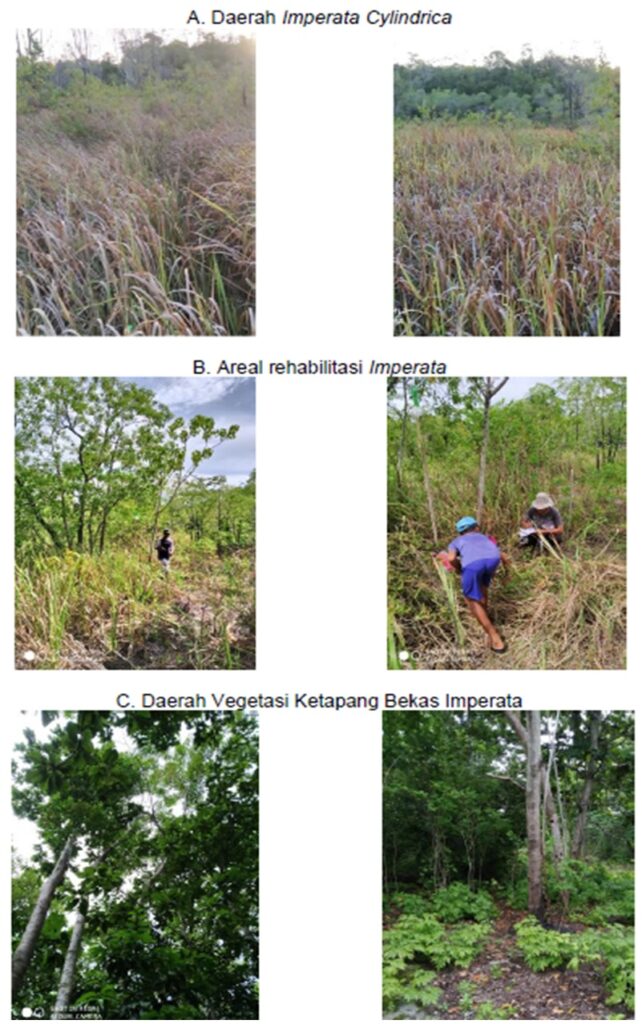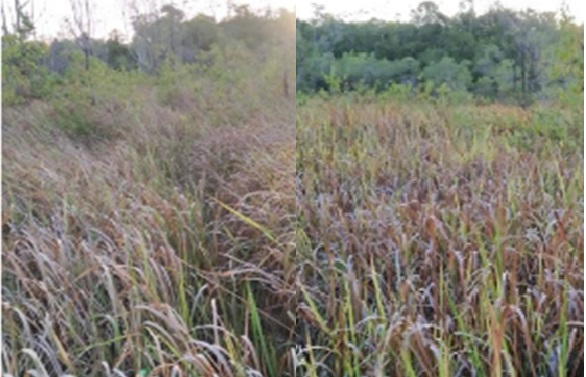The low density of trees in the Imperata successional community area caused low biomass, affecting the number of carbon stocks above and below ground. The highest above-ground (tree) carbon stocks were found in the Terminalia vegetation area of 33.796 t/ha, followed by the rehabilitation area of 10.925 t/ha, and the lowest was in Imperata grassland area of 3.428 t/ha. The results of the lowest above-ground (trees) carbon stocks in the Imperata cylindrica area were also reported by Donato et al. (2012) on study in the dominant areas of savanna vegetation in the Micronesian Islands Group Yap and Palau. The calculation of the carbon stocks of the top of the tree on Yap Island was 3.00 t/ha, while it was only 0.50 t/ha on Palau Island. The results of the total carbon calculation show that the Terminalia vegetation area has the highest carbon per hectare of 137.977 t/ha in the following order: above-ground (trees) (33.795 t/ha), soil (96.717 t/ha), below-ground (roots) (6.557 t/ha), necromass (0.396 t/ha), litter (0.327 t/ha), small necromass (0.044 t/ha) and understorey (0.140 t/ha). The total carbon stocks of the Imperata succession community per hectare on Marsegu Island can be seen in Table 1.
Table 1. Total carbon stocks of the Imperata succession community (t/ha).
| No | Carbon Stocks | Imperata Grassland Area (t/ha) | Rehabilitation Area (t/ha) | Terminalia Vegetation Area (t/ha) |
| 1 | Above-Ground (Trees) | 3.428 | 10.925 | 33.796 |
| 2 | Necromass: Ø ≥ 10 | – | 0.082 | 0.396 |
| 3 | Small Necromass: Ø >5 to <10cm | 0.003 | 0.010 | 0.044 |
| 4 | Understorey | 3.080 | 0.912 | 0.140 |
| 5 | Litter | 0.372 | 0.438 | 0.327 |
| 6 | Below-Ground (roots) | 0.765 | 2.505 | 6.557 |
| 7 | Soil | 122.307 | 68.048 | 96.717 |
| Total | 129.955 | 82.920 | 137.977 |
Below-ground carbon stocks show that the Terminalia vegetation area has larger carbon stocks than the rehabilitation and Imperata grassland areas. The Terminalia vegetation area has below-ground carbon stocks of 6.557 t/ha, followed by a rehabilitation area of 2.505 t/ha, and the lowest was in the Imperata grassland area of 0.765 t/ha. Low below-ground carbon stocks were also found in the dominant areas of savanna vegetation in the Micronesian Islands Groups of Yap and Palau. According to Donato et al. (2012), the below-ground (roots) carbon stock of the savanna area on Yap Island was 0.70 t/ha, while on Palau Island, it was merely 0.10 t/ha.

The highest understorey carbon content in the Imperata successional community was found in the Imperata grassland area, followed by the rehabilitation area, and the lowest in the Terminalia vegetation area. The carbon stocks for the understorey of the Imperata grassland area was 3.080 t/ha, the rehabilitation area was 0.912 t/ha, and the Terminalia vegetation area was 0.140 t/ha. The dense canopy of Terminalia vegetation complicates understorey to develop; only shade-tolerant species, i.e. Tacca leontopetaloides, can grow well. Understorey species in the rehabilitation area were Imperata cylindrica, Ischaemum timorense, Physalis angulata and Chloris barbata.
Rhizoma Imperata cylindrica can comprise more than 60% of the total plant biomass, and this low shoot-root/rhizome ratio contributes to rapid regrowth after burning or pruning (Hamidavi et al., 2021). Rhizoma Imperata cylindrica is white and hard with shortened segments. Rhizomes are covered with brown cataphylls (scales), which form a protective sheath around the rhizome (Mac Donald, 2004). Estimation of carbon stocks in the dominant areas of savanna vegetation in the Micronesian Islands Group of Yap and Palau shows that understorey carbon stocks on Yap Island were 6.60 t/ha while on Palau Island were 4.60 t/ha (Donato et al., 2012).
The highest estimated total carbon stocks in the Imperata succession community on Marsegu Island was in the Terminalia vegetation area of 137.977 t/ha, followed by the Imperata grassland area of 129.955 t/ha and the lowest was in the rehabilitation area of 82.920 t/ha. Estimation of total carbon stocks in the Imperata cylindrica area in Sumatra and East Kalimantan showed lower results than the total carbon stocks in the Imperata grassland area in Marsegu Island. The results of calculating total carbon stocks in Sumatra were 16.90 t/ha, while in East Kalimantan was 21.90 t/ha (Syahrinudin et al., 2020).
Study results on the dominant areas of savanna vegetation in the Micronesian Islands Group of Yap and Palau showed that the total carbon stocks on Yap Island was 156.00 t/ha, while on Palau Island, it was 203.00 t/ha (Donato et al., 2012). Imperata cylindrica soils have a high capacity to reduce atmospheric CO2 and induce high carbon stocks into the soil, provided they are protected from burning and overgrazing (Thokchom and Yadava, 2016). Read More >>>
Citation:
Irwanto, I., Paembonan, S.A., Ngakan, P.O., Maulany, R.I., Sahupala, A. and Yatim, H., 2024. Imperata vegetation succession and carbon stocks on degraded land of beach forest in Marsegu Island, Maluku, Indonesia. Journal of Degraded & Mining Lands Management, 11(2).

Hi, this is a comment.
To get started with moderating, editing, and deleting comments, please visit the Comments screen in the dashboard.
Commenter avatars come from Gravatar.